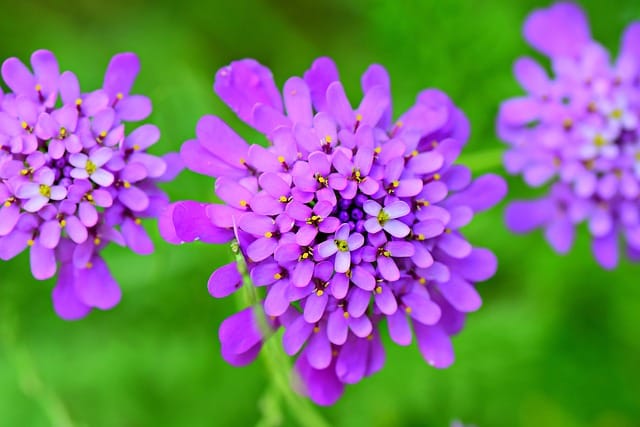How to grow Candytufts
Candytufts (Iberis) are beautiful flowering plants that belong to the Brassicaceae family

In this article:
- Introduction to Candytufts
- Choosing the Right Variety
- Climate and Soil Requirements
- Propagation Methods
- Preparing the Site for Planting
- Planting Candytufts
- Watering and Care Instructions
- Dealing with Common Pests and Diseases
- Pruning and Deadheading Tips
- Harvesting and Using Candytufts
- Overwintering Candytufts
- Frequently Asked Questions about Candytufts
Introduction to Candytufts
Candytufts (Iberis) are beautiful flowering plants that belong to the Brassicaceae family. They are known for their clusters of small, candy-like flowers that appear in various shades of pink, white, and purple. Candytufts are popular in gardens and are commonly used in borders, rockeries, and cottage gardens.
Choosing the Right Variety
There are several varieties of Candytufts available, each with its own unique features. Some popular varieties include 'Snowflake', 'Purity', 'Little Gem', and 'Masterpiece'. Consider the height, spread, color, and blooming season of the different varieties to choose the right one for your garden.
Climate and Soil Requirements
Candytufts thrive in areas with mild climates and prefer full sun. They can tolerate some shade but may not bloom as profusely. Candytufts prefer well-draining soil and are tolerant of different soil types, including sandy or rocky soil. Before planting, ensure the soil pH is neutral to slightly alkaline.
Propagation Methods
Candytufts can be propagated by seeds or cuttings. Seeds can be sown directly in the garden in early spring or started indoors 6-8 weeks before the last frost. Cuttings can be taken in late spring or early summer, ensuring they have at least two leaf nodes. Use a rooting hormone and plant them in moist, well-draining soil.
Preparing the Site for Planting
Prepare the planting site by clearing any weeds, grass, or debris. Loosen the soil using a garden fork or a tiller to a depth of about 6-8 inches. Add organic matter such as compost or well-rotted manure to improve drainage and fertility. Level the area before planting.
Planting Candytufts
Plant Candytufts about 8-10 inches apart, allowing enough space for them to spread. Dig a hole slightly larger than the nursery container or root ball. Place the plant in the hole and backfill with soil, firmly pressing it around the base of the plant. Water thoroughly after planting to settle the soil.
Watering and Care Instructions
Keep the soil consistently moist but not waterlogged, especially during the first few weeks after planting. Once established, Candytufts are relatively drought-tolerant and only require watering during prolonged dry periods. Mulching around the plants helps conserve moisture and suppress weeds.
Dealing with Common Pests and Diseases
Candytufts are generally resistant to pests and diseases. However, they may occasionally encounter issues with aphids, slugs, or powdery mildew. Regular monitoring, proper sanitation, and the use of organic pest control methods can help manage these problems effectively.
Pruning and Deadheading Tips
Candytufts benefit from regular pruning and deadheading to promote bushy growth and encourage continuous blooming. After the first flowering, trim back the plants by about one-third to remove spent flowers and encourage new growth. Pruning in late winter or early spring helps maintain a compact shape.
Harvesting and Using Candytufts
Candytufts make lovely cut flowers, and you can harvest them when the blooms are fully open. Snip the stems just above a leaf node to encourage further growth. These flowers look beautiful in bouquets and can be used for floral arrangements. Ensure you leave enough flowers on the plant for pollinators.
Overwintering Candytufts
Candytufts are generally hardy and can withstand frost and mild winter conditions. However, in colder regions, it is advisable to provide winter protection by mulching around the plants with straw or leaves. This helps insulate the roots and prevent frost-heaving.
Frequently Asked Questions about Candytufts
Q: Are Candytufts deer resistant?
A: Yes, Candytufts are typically deer resistant due to their bitter taste and strong fragrance.
Q: How often should I fertilize Candytufts?
A: Candytufts do not require heavy fertilization. Applying a balanced, slow-release fertilizer in early spring is usually sufficient.
Q: Can Candytufts be grown in containers?
A: Yes, Candytufts can be grown in containers as long as they have adequate drainage and receive sufficient sunlight.
Q: Do Candytufts attract bees and butterflies?
A: Yes, Candytufts are attractive to bees, butterflies, and other beneficial pollinators.
By following these guidelines, you can successfully grow Candytufts in your garden. Enjoy their delightful blooms and add beauty to your outdoor space!
